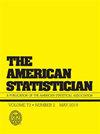数据随机缺失时基于正态分布的伪极大似然估计的一致性。
IF 1.8
4区 数学
Q1 STATISTICS & PROBABILITY
引用次数: 15
摘要
本文表明,当缺失值变量与观测值线性相关时,基于正态分布的伪最大似然值仍然是一致的。总体分布可能是未知的,而数据丢失过程可能遵循任意丢失和随机机制。为二元情况提供了足够的细节,以便参加过统计/概率课程的读者可以充分理解其发展。文中还给出了mle在高维上一致性的充分条件,但省略了细节。本文章由计算机程序翻译,如有差异,请以英文原文为准。
Consistency of Normal Distribution Based Pseudo Maximum Likelihood Estimates When Data Are Missing at Random.
This paper shows that, when variables with missing values are linearly related to observed variables, the normal-distribution-based pseudo MLEs are still consistent. The population distribution may be unknown while the missing data process can follow an arbitrary missing at random mechanism. Enough details are provided for the bivariate case so that readers having taken a course in statistics/probability can fully understand the development. Sufficient conditions for the consistency of the MLEs in higher dimensions are also stated, while the details are omitted.
求助全文
通过发布文献求助,成功后即可免费获取论文全文。
去求助
来源期刊

American Statistician
数学-统计学与概率论
CiteScore
3.50
自引率
5.60%
发文量
64
审稿时长
>12 weeks
期刊介绍:
Are you looking for general-interest articles about current national and international statistical problems and programs; interesting and fun articles of a general nature about statistics and its applications; or the teaching of statistics? Then you are looking for The American Statistician (TAS), published quarterly by the American Statistical Association. TAS contains timely articles organized into the following sections: Statistical Practice, General, Teacher''s Corner, History Corner, Interdisciplinary, Statistical Computing and Graphics, Reviews of Books and Teaching Materials, and Letters to the Editor.
 求助内容:
求助内容: 应助结果提醒方式:
应助结果提醒方式:


